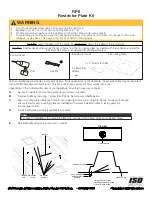
6RL SERIES OPERATION MANUAL
SECTION 7: REMOTE PROGRAMMING
Entire Contents Copyright
2018 by Adaptive Power Systems, Inc. (APS) • All Rights Reserved • No reproduction without written authorization from APS.
6RL Series Regenerative DC Load Operation Manual
Page 150 of 204
A response, which should be instantly coming from the unit, will return a value between 0%
and max. 125% of nominal unit power, for example “2534 W”. No matter how the actual
power format is in the unit’s display, here it will always be returned in Watts.
7.12.7.4
MEASure:[SCALar:]ARRay?
Queries the unit to return the last measured resp. calculated actual values of voltage,
current and power (in that sequence), separated by commas and with unit and eventually
magnitude.
Example:
MEAS:ARR?
Absolute short form. A response, which should be instantly
coming from the unit, will return three values between 0%
and max. 125% of nominal unit values, for example “12.5 V,
33.3 A, 420 W”
7.12.8
Status commands
Status commands are used to alter the status of the unit in terms of activating remote
control or switching the DC Input, or to query the current status.
7.12.8.1
SYSTem:LOCK
˽
<B0>
This command is used to activate remote control of a unit. The remote control has to be
activated first before you can send any command that changes unit status or value. Once
remote control has been activated via one of the digital interfaces, only that interface is in
charge.
The activation of remote control can be refused by the unit due to several reasons. It usually
results in a SCPI error which is put into the SCPI error buffer. This buffer can be read with
the error command (SYSTem:ERRor?).
Query form:
SYSTem:LOCK:OWNer?
Value range for set:
ON, OFF
Value range for query:
REMOTE, NONE, LOCAL
Examples:
SYST:LOCK˽ON
Absolute short form. Requests the unit to switch to remote
control. The unit then usually indicates activated remote
control either by a LED or a status text in the display.
SYSTEM:LOCK:OWNER?
Queries the lock owner regarding remote control. This can
be used to verify whether the unit has accepted the request
to switch to remote control or not. It can return three
different statuses:
REMOTE = Unit is in remote control via any of the available
interfaces
NONE = Unit is not in remote control
Summary of Contents for 6RL Series
Page 203: ......
















































